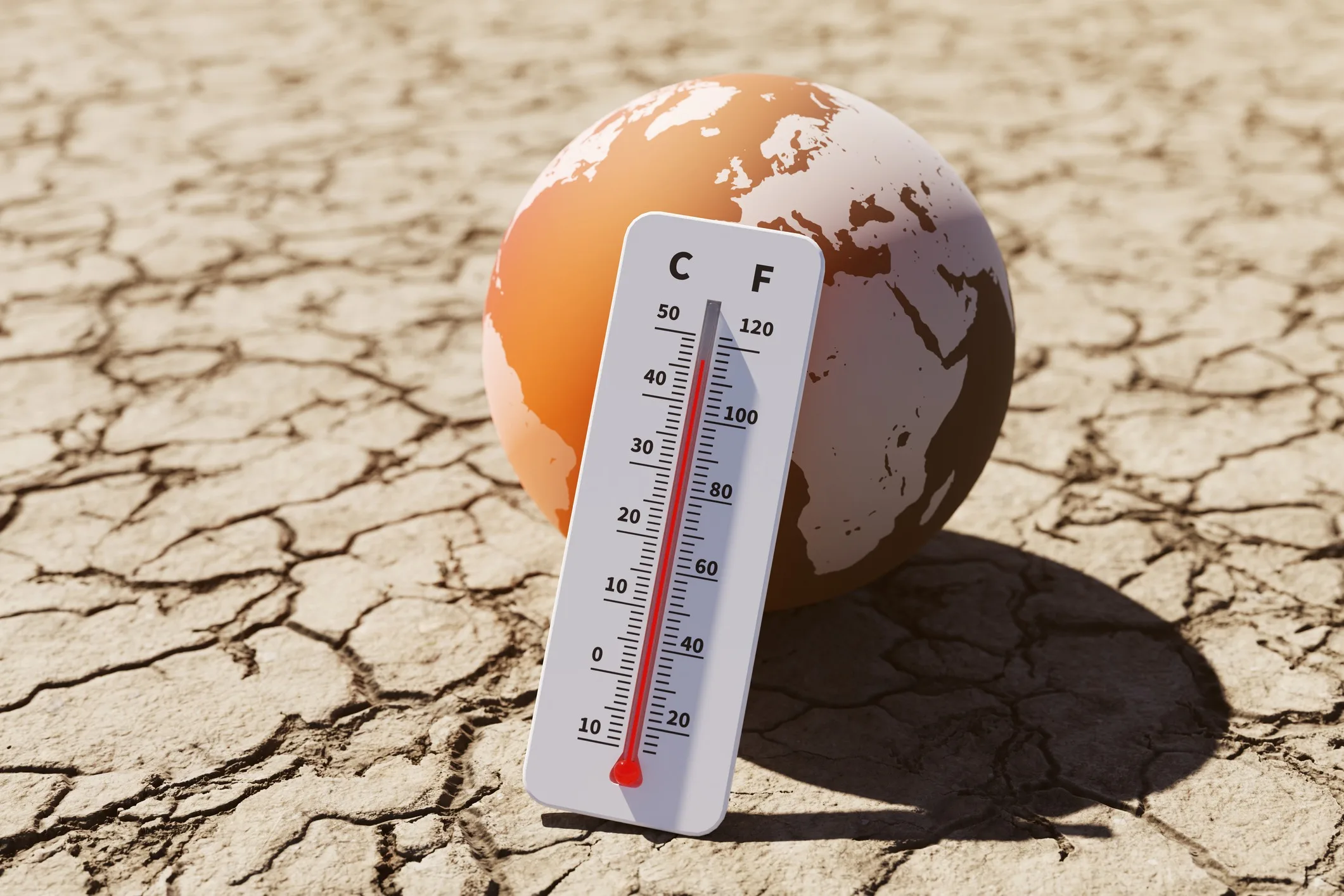Home>Weather and Climate>The Impact Of Temperatures On The Environment: A Comprehensive Guide


Weather and Climate
The Impact Of Temperatures On The Environment: A Comprehensive Guide
Published: March 2, 2024
Explore the profound effects of weather and climate on the environment in this comprehensive guide. Learn about the impact of temperatures and gain valuable insights.
(Many of the links in this article redirect to a specific reviewed product. Your purchase of these products through affiliate links helps to generate commission for Temperatures.com, at no extra cost. Learn more)
Table of Contents
Introduction
The impact of temperatures on the environment is a topic of critical importance in today's world. As global temperatures continue to rise, the resulting effects on ecosystems, weather patterns, human health, and agriculture are becoming increasingly evident. Understanding the intricate relationship between temperature and the environment is essential for addressing the challenges posed by climate change and implementing effective mitigation strategies.
Rising temperatures are primarily attributed to the enhanced greenhouse effect, a phenomenon driven by the accumulation of greenhouse gases in the Earth's atmosphere. This process has led to a gradual warming of the planet, triggering a cascade of environmental repercussions. By delving into the mechanisms of the greenhouse effect and its implications, we can gain valuable insights into the far-reaching consequences of temperature fluctuations on the natural world and human societies.
In this comprehensive guide, we will explore the multifaceted impact of rising temperatures on various aspects of the environment. From the disruption of ecosystems to the alteration of weather patterns, the ramifications of temperature changes are profound and wide-ranging. Moreover, we will delve into the effects of temperature on human health and its influence on agricultural practices, shedding light on the interconnectedness of these elements with the broader environmental landscape.
By examining the intricate interplay between temperature and the environment, we can discern the urgency of implementing measures to mitigate the adverse effects of rising temperatures. Through the exploration of strategies aimed at addressing climate change and its associated challenges, we can pave the way for a more sustainable and resilient future.
Join us on this enlightening journey as we unravel the complexities of temperature's impact on the environment and delve into the pivotal role of collective action in safeguarding the planet for generations to come.
Understanding the Greenhouse Effect
The greenhouse effect is a natural process that plays a crucial role in regulating the Earth's temperature. It involves the retention of heat in the Earth's atmosphere, creating a stable and habitable climate for life to thrive. This phenomenon is driven by the presence of greenhouse gases, such as carbon dioxide, methane, water vapor, and nitrous oxide, which trap heat from the sun and prevent it from escaping back into space.
When solar radiation reaches the Earth's surface, some of it is absorbed and warms the planet. The Earth then emits this absorbed energy in the form of infrared radiation. Greenhouse gases in the atmosphere absorb and re-radiate a portion of this infrared radiation, effectively trapping heat and maintaining a relatively consistent temperature across the globe.
However, human activities, particularly the burning of fossil fuels, deforestation, and industrial processes, have significantly increased the concentration of greenhouse gases in the atmosphere. This enhanced greenhouse effect has led to a gradual rise in global temperatures, a phenomenon commonly referred to as global warming.
The consequences of this warming trend are far-reaching, impacting ecosystems, weather patterns, and human societies. As temperatures continue to rise, the delicate balance of the Earth's climate is disrupted, leading to more frequent and severe weather events, shifts in precipitation patterns, and alterations in the distribution of plant and animal species.
Understanding the greenhouse effect is pivotal in comprehending the mechanisms driving climate change. By recognizing the role of greenhouse gases in regulating the Earth's temperature and the implications of human-induced changes to this delicate balance, we can appreciate the urgency of taking proactive measures to mitigate the impact of rising temperatures on the environment.
As we delve deeper into the intricate dynamics of the greenhouse effect, it becomes evident that concerted efforts to reduce greenhouse gas emissions and transition towards sustainable energy sources are imperative in safeguarding the planet's ecological equilibrium. By fostering a deeper understanding of this fundamental process, we can cultivate a collective commitment to preserving the delicate balance of the Earth's climate for current and future generations.
Effects of Rising Temperatures on Ecosystems
Rising temperatures exert profound effects on ecosystems, disrupting the delicate balance of natural habitats and triggering a myriad of ecological transformations. One of the most notable impacts is the alteration of species distributions and migration patterns. As temperatures increase, many plant and animal species are compelled to shift their ranges in search of suitable climates, leading to potential mismatches with essential resources and disrupting established ecological interactions. This phenomenon poses significant challenges for the conservation of biodiversity, as it may result in the fragmentation of habitats and the loss of critical species.
Moreover, rising temperatures can exacerbate the frequency and intensity of extreme weather events, such as heatwaves, droughts, and intense storms, which can have devastating consequences for ecosystems. These events can lead to widespread habitat destruction, loss of biodiversity, and disruptions in ecological processes, ultimately compromising the resilience of natural systems. Additionally, the increased frequency of wildfires, often fueled by prolonged periods of high temperatures and drought, poses a significant threat to forest ecosystems, leading to long-term ecological degradation and loss of vital habitats for numerous species.
Furthermore, rising temperatures can have cascading effects on marine ecosystems, particularly through ocean warming and acidification. These changes can disrupt marine food webs, impact the distribution of species, and lead to the degradation of coral reefs and other sensitive marine habitats. The resulting decline in marine biodiversity can have far-reaching consequences, affecting fisheries, coastal communities, and the overall health of the oceans.
In terrestrial ecosystems, rising temperatures can also influence the timing of seasonal events, such as flowering, leaf emergence, and migration, leading to mismatches between species interactions and disrupting the intricate web of ecological relationships. These disruptions can have ripple effects throughout the food chain, potentially compromising the stability and functioning of entire ecosystems.
As the effects of rising temperatures on ecosystems continue to unfold, it becomes increasingly evident that concerted efforts to mitigate climate change and protect vulnerable habitats are essential. By implementing measures to reduce greenhouse gas emissions, conserve critical habitats, and promote sustainable land and ocean management practices, we can strive to safeguard the resilience and biodiversity of ecosystems in the face of ongoing temperature changes. Through proactive conservation and restoration initiatives, we can work towards fostering resilient ecosystems capable of adapting to the challenges posed by rising temperatures, thereby ensuring the continued provision of vital ecosystem services and the preservation of Earth's rich natural heritage.
Impact of Temperature on Weather Patterns
The impact of temperature on weather patterns is a fundamental aspect of the intricate dynamics shaping the Earth's climate system. As global temperatures continue to rise, the influence on weather phenomena becomes increasingly pronounced, giving rise to a spectrum of far-reaching effects.
One of the most notable consequences of rising temperatures is the intensification of extreme weather events. Heatwaves, droughts, heavy precipitation, and severe storms are among the manifestations of a climate system responding to heightened thermal energy. These events can have profound implications for human societies, ecosystems, and infrastructure, posing significant challenges for adaptation and resilience.
Moreover, the alteration of temperature patterns can lead to shifts in precipitation regimes, influencing the distribution and availability of water resources. Regions may experience changes in rainfall patterns, including more frequent or prolonged dry spells, as well as intense precipitation events. These shifts can impact agricultural productivity, water security, and the prevalence of drought conditions, exerting substantial socio-economic repercussions.
Furthermore, rising temperatures can contribute to the melting of polar ice caps and glaciers, leading to sea-level rise and alterations in ocean circulation patterns. These changes can influence regional climates, exacerbate coastal flooding risks, and disrupt marine ecosystems, underscoring the interconnected nature of temperature dynamics and weather phenomena.
The intricate interplay between temperature and weather patterns underscores the urgency of addressing climate change and its associated impacts. By enhancing our understanding of these complex relationships, we can strive to develop robust adaptation strategies, improve early warning systems for extreme weather events, and bolster infrastructure resilience to mitigate the effects of changing temperature patterns on weather dynamics.
In essence, the impact of temperature on weather patterns encompasses a spectrum of interconnected processes that necessitate a holistic approach to climate resilience and adaptation. By acknowledging the profound influence of rising temperatures on weather phenomena, we can work towards fostering a more resilient and prepared global community in the face of evolving climate dynamics.
Human Health and Temperature
The relationship between temperature and human health is a critical facet of the broader impact of rising temperatures on the environment. As global temperatures continue to climb, the ramifications for human well-being and public health are becoming increasingly apparent. From heat-related illnesses to the spread of vector-borne diseases, the influence of temperature on human health is multifaceted and pervasive.
One of the most immediate and pronounced effects of rising temperatures is the heightened risk of heat-related illnesses. Prolonged exposure to extreme heat can lead to heat exhaustion, heatstroke, and dehydration, posing significant threats to individuals, particularly the elderly, children, and those with pre-existing health conditions. Moreover, rising temperatures can exacerbate air pollution, leading to respiratory issues and cardiovascular complications, further amplifying the health risks associated with elevated temperatures.
In addition to direct health impacts, rising temperatures can also influence the prevalence and distribution of infectious diseases. The expansion of suitable habitats for disease-carrying vectors, such as mosquitoes and ticks, can contribute to the spread of illnesses like malaria, dengue fever, and Lyme disease. Furthermore, changes in temperature and precipitation patterns can affect the transmission dynamics of water and foodborne diseases, potentially increasing the incidence of gastrointestinal infections and waterborne illnesses.
Furthermore, rising temperatures can have profound mental health implications, particularly in the context of extreme weather events and climate-related disasters. The psychological stress and trauma associated with natural disasters, exacerbated by temperature extremes, can have enduring effects on mental well-being, underscoring the interconnected nature of temperature dynamics and human health outcomes.
Addressing the complex interplay between temperature and human health requires a multifaceted approach, encompassing public health interventions, climate-resilient infrastructure, and community-based adaptation strategies. By implementing heatwave early warning systems, enhancing access to cooling centers, and promoting heat-safe behaviors, communities can mitigate the health risks associated with extreme temperatures. Additionally, bolstering healthcare systems to respond to climate-related health challenges and advancing research on climate-health interactions are pivotal in safeguarding human well-being in the face of rising temperatures.
In essence, the impact of temperature on human health underscores the imperative of prioritizing public health adaptation and resilience measures in the context of a changing climate. By recognizing the multifaceted health risks posed by rising temperatures and implementing proactive interventions, societies can strive to protect vulnerable populations and foster a healthier, more resilient global community.
Temperature's Influence on Agriculture
Temperature plays a pivotal role in shaping agricultural productivity and the overall dynamics of food production systems. The influence of temperature on agriculture encompasses a spectrum of interconnected processes that profoundly impact crop growth, soil health, and the prevalence of pests and diseases. As global temperatures continue to rise, the implications for agricultural systems are becoming increasingly pronounced, necessitating a comprehensive understanding of the intricate relationship between temperature dynamics and food security.
One of the primary ways in which temperature affects agriculture is through its influence on crop development and phenology. Temperature directly impacts the rate of plant growth, flowering, and fruit set, thereby influencing the timing and yield of agricultural crops. Optimal temperature ranges are critical for ensuring the successful germination, vegetative growth, and reproductive stages of crops, with deviations from these ranges potentially leading to reduced yields and compromised crop quality. Moreover, rising temperatures can alter the geographical distribution of suitable climates for various crops, necessitating adjustments in planting schedules and agricultural practices to adapt to changing temperature patterns.
Furthermore, temperature dynamics significantly influence soil health and nutrient cycling, which are essential determinants of agricultural productivity. Temperature variations can impact microbial activity in the soil, affecting nutrient availability and decomposition processes. Additionally, extreme temperature events, such as heatwaves and frosts, can exert stress on crops and disrupt soil microbial communities, potentially leading to diminished soil fertility and reduced crop resilience. These effects underscore the intricate interplay between temperature and soil dynamics, highlighting the need for sustainable soil management practices to mitigate the impact of rising temperatures on agricultural productivity.
In addition to direct effects on crops and soil, temperature influences the prevalence and behavior of agricultural pests and diseases. Changes in temperature patterns can alter the geographic range and life cycles of pests, leading to shifts in pest pressure and the emergence of new pest species in agricultural regions. Moreover, temperature fluctuations can influence the incidence and severity of plant diseases, impacting crop health and yield potential. These dynamics underscore the importance of integrated pest management strategies and disease surveillance systems to mitigate the risks posed by temperature-induced changes in pest and disease dynamics.
Addressing the influence of temperature on agriculture requires a holistic approach that integrates climate-resilient agricultural practices, precision farming technologies, and adaptive crop management strategies. By promoting agroecological approaches, enhancing climate-smart agricultural techniques, and advancing research on temperature-crop interactions, agricultural systems can strive to adapt to changing temperature dynamics and bolster food security in the face of climate change.
In essence, the influence of temperature on agriculture underscores the imperative of prioritizing climate-resilient agricultural practices and adaptive strategies to safeguard global food production systems. By recognizing the multifaceted impacts of rising temperatures on agricultural productivity and implementing proactive measures, agricultural communities can work towards fostering sustainable and resilient food systems capable of withstanding the challenges posed by a changing climate.
Strategies for Mitigating the Impact of Rising Temperatures
Mitigating the impact of rising temperatures necessitates a concerted and multifaceted approach that encompasses a spectrum of proactive strategies aimed at addressing climate change and fostering resilience in the face of evolving temperature dynamics. From reducing greenhouse gas emissions to enhancing climate adaptation measures, the pursuit of effective mitigation strategies is pivotal in safeguarding the environment, human societies, and vital ecosystems.
One of the primary strategies for mitigating the impact of rising temperatures is the reduction of greenhouse gas emissions through the adoption of clean and renewable energy sources. Transitioning away from fossil fuels and embracing sustainable energy technologies, such as solar, wind, and hydroelectric power, can significantly curtail the accumulation of greenhouse gases in the atmosphere, thereby mitigating the drivers of global warming.
Furthermore, enhancing energy efficiency across various sectors, including transportation, industry, and buildings, is instrumental in reducing carbon emissions and minimizing the heat-trapping effects of greenhouse gases. By promoting energy-efficient technologies, improving urban planning to reduce energy consumption, and advancing sustainable transportation systems, societies can strive to mitigate the impact of rising temperatures on the environment.
In addition to emission reduction efforts, implementing nature-based solutions, such as afforestation, reforestation, and sustainable land management practices, can play a pivotal role in sequestering carbon and enhancing ecosystem resilience. Restoring degraded landscapes, conserving natural habitats, and promoting sustainable forestry practices are essential components of mitigating the impact of rising temperatures on ecosystems and biodiversity.
Moreover, investing in climate-resilient infrastructure, such as flood defenses, drought-resistant water systems, and resilient urban design, is critical for adapting to changing temperature dynamics and minimizing the vulnerability of communities to climate-related hazards. By integrating climate considerations into infrastructure planning and development, societies can enhance their capacity to withstand the impacts of rising temperatures and extreme weather events.
Additionally, fostering international cooperation and collective action is essential in addressing the global nature of climate change. By promoting knowledge sharing, technology transfer, and capacity building among nations, the international community can work towards implementing effective mitigation and adaptation strategies, thereby fostering a more resilient and sustainable future for all.
In essence, the pursuit of strategies for mitigating the impact of rising temperatures encompasses a comprehensive and collaborative endeavor that demands proactive measures, innovative solutions, and sustained commitment. By embracing a holistic approach to climate resilience and sustainability, societies can strive to mitigate the far-reaching effects of rising temperatures and pave the way for a more resilient and harmonious coexistence with the natural world.
Conclusion
In conclusion, the impact of temperatures on the environment is a multifaceted and far-reaching phenomenon that permeates every facet of the natural world and human societies. From the intricate dynamics of the greenhouse effect to the profound implications for ecosystems, weather patterns, human health, and agriculture, rising temperatures are reshaping the fabric of our planet in profound ways. As global temperatures continue to climb, the urgency of addressing climate change and its associated challenges becomes increasingly apparent.
The understanding of the greenhouse effect and its role in regulating the Earth's temperature provides valuable insights into the mechanisms driving climate change. The accumulation of greenhouse gases, primarily attributed to human activities, has disrupted the delicate balance of the Earth's climate, leading to a gradual warming of the planet. This warming trend has set in motion a cascade of environmental repercussions, from the disruption of ecosystems to the intensification of extreme weather events, underscoring the imperative of mitigating the impact of rising temperatures.
The effects of rising temperatures on ecosystems are profound and wide-ranging, encompassing shifts in species distributions, alterations in habitat dynamics, and disruptions in ecological processes. The intensification of extreme weather events, coupled with the cascading effects on marine and terrestrial ecosystems, highlights the vulnerability of natural systems to temperature fluctuations. Concerted efforts to mitigate climate change and protect vulnerable habitats are essential in safeguarding the resilience and biodiversity of ecosystems in the face of ongoing temperature changes.
Moreover, the influence of temperature on weather patterns underscores the interconnected nature of climate dynamics, giving rise to a spectrum of far-reaching effects, from the intensification of extreme weather events to shifts in precipitation regimes and alterations in ocean circulation patterns. The imperative of addressing climate change and its associated impacts becomes increasingly evident in the context of evolving temperature patterns and their implications for weather phenomena.
The relationship between temperature and human health is a critical facet of the broader impact of rising temperatures on the environment. The heightened risks of heat-related illnesses, the spread of infectious diseases, and the mental health implications of extreme weather events underscore the imperative of prioritizing public health adaptation and resilience measures in the context of a changing climate.
Furthermore, the influence of temperature on agriculture encompasses a spectrum of interconnected processes that profoundly impact crop growth, soil health, and the prevalence of pests and diseases. By recognizing the multifaceted impacts of rising temperatures on agricultural productivity and implementing proactive measures, agricultural communities can work towards fostering sustainable and resilient food systems capable of withstanding the challenges posed by a changing climate.
In the pursuit of strategies for mitigating the impact of rising temperatures, a concerted and multifaceted approach is essential. From reducing greenhouse gas emissions to enhancing climate adaptation measures, the pursuit of effective mitigation strategies is pivotal in safeguarding the environment, human societies, and vital ecosystems. By embracing a holistic approach to climate resilience and sustainability, societies can strive to mitigate the far-reaching effects of rising temperatures and pave the way for a more resilient and harmonious coexistence with the natural world.
In essence, the impact of temperatures on the environment underscores the urgency of implementing measures to mitigate the adverse effects of rising temperatures. By fostering a deeper understanding of the intricate interplay between temperature and the environment and embracing proactive strategies for climate resilience, we can pave the way for a more sustainable and resilient future for current and future generations.














